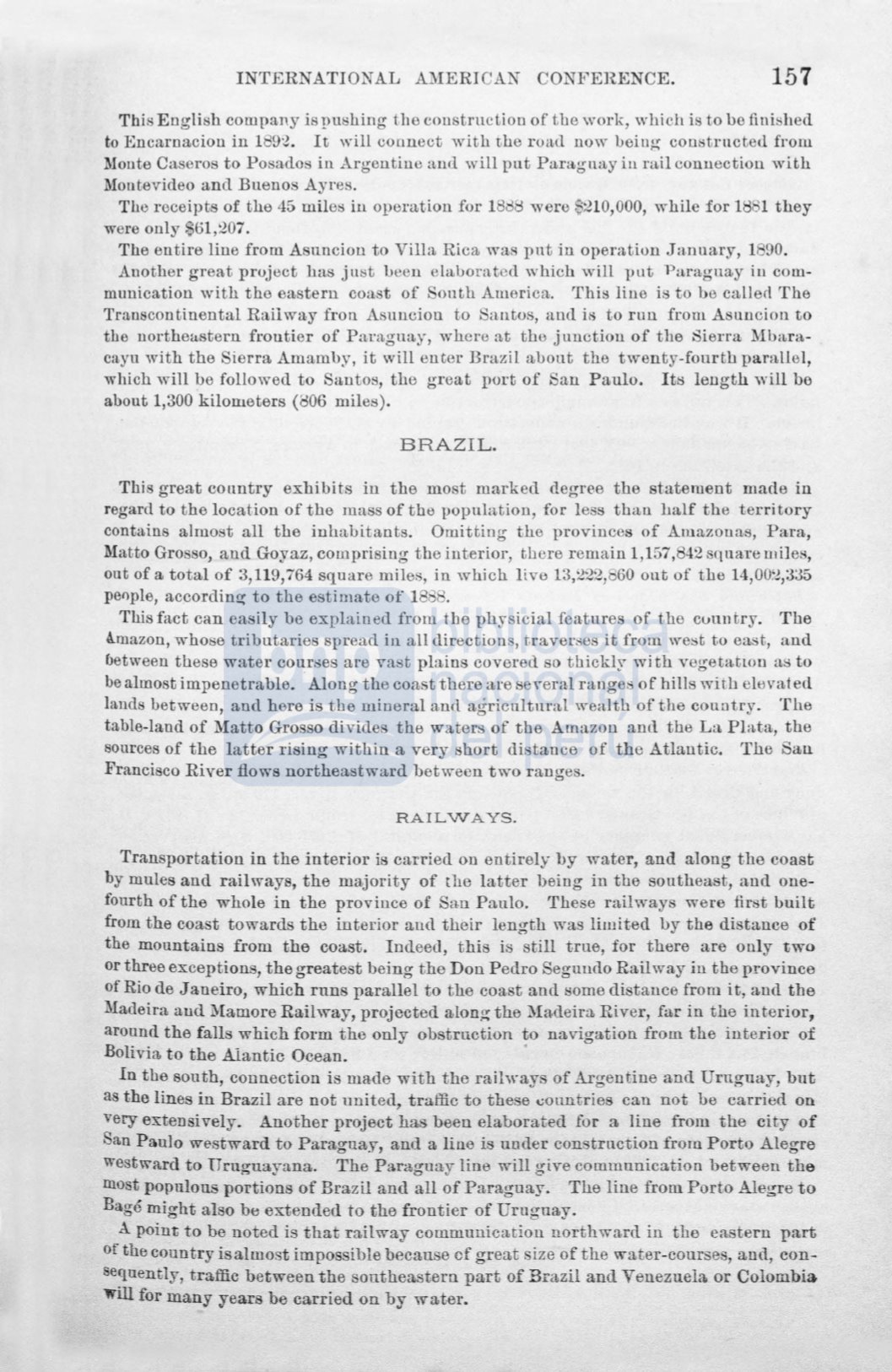

INTERNATIONAL AMERICAN CONFERENCE.
157
Thi.' English company is pushing the construction of the work, which is to be finished
to Encarnaciou in 1
9~.
It will connect with the roacl now beiug constructeu frorn
Monte Caseros to Posados in Argentine ancl will put Paraguay iu rail conuection with
Montevideo and Buenos Ayres.
The receipts of the 45 miles iu opera.tion for 181:38 were $210,000, while for 18 1 they
were ouly $61,207.
The entire liue from Asunciou to Villa Rica was pnt in opemtion Ja.nnary, 1 90.
Another great project has just been elaborated whích will put Paraguay iu com–
municatíon with the eastern coast of outh Arnerica. This liue is to be callea The
Tmnscontinental Railway fron Asuncion to Santos, and is to run from Asunciou to
the uortheastern froutier of Paraguay, whcre at the j unction of the Sierra Mbara–
cayu with the Sierra Amamby, it will euter Brazil about the twenty-fourth parallel,
which will be followed to Santos, the great port of San Paulo. It::> length will be
about 1,300 kilometers (806 miles).
BRAZIL.
This great conntry exhibits in the most marked degree the statement made in
regard to the location of the mass of the population, for less thau ltalf the terri tory
contains almost all the inhabitants. Omitting tlte provinces of Amazonas, Para,
Matto Grosso, and Goyaz, comprising t he interior, there remain 1,157,842 quare otiles,
out of a total of 3,119,764 square miles, in which live 13,::!22,860 out of the 14,00:J,3:35
pellple, according- to the estímate of 188 .
This fact can easily be explained from the physicial features of the cuuntry. The
A-mazon, whose tributarias spread in all directions, traverses it from west to ea ·t, and
óetween these water cour ·es are vast pl::Lins covered so thickly wi th vegetatwn asto
be almostimpenetrable. Along the coast there are se\eral range::> of bilis with eleva.ted
lands between, and h ere is the mineral ancl agricultnra.l wealth of the country. The
table-land of Matto Grosso div ide the waters of the Amazon and the La Plata, the
sources of the latter rising within a very short di tance of the Atlautic. The San
Francisco River flows northeastward betwecn two rauges.
RAILWAYS.
Transportation in the interior is carried ou entirely by water, and along the coast
by mules and railways, the majority of the latter being in the southeast, and one–
fourth of the whole in the proviuce of San Paulo. These railways were first built
from the coast towards the interior aud their length was limited by the distance of
the mountains from the coast. Indeed, t his is still true, for there are only two
orthree exceptions, thegreatest being the Don Pedro Segundo Railway in the province
ofRio de Janeiro, which runs parallel to the coast and
~:~ome
distance from it, and tbe
Madeira aud Mamore Railway, projected along the Madeira River, far in the interior,
around the falls which form the only obstrnction to navigation from the interior of
Bolivia to the .A.lantic Ocean.
In tbe south, counection is made with the rail\\'ay of Argentino and Uruguay, but
as the lines in Brazil are not united, traffic to the e coLmtries can not be carried on
very extensively. Anotber project has been elaborated for a line from the city of
San P aulo westward to Paraguay, and a liue
i.s
under construction frorn Porto Alegre
westward to Drnguayana. The Paraguay line will give communication between the
most popnlons portions of Brazil and all of Paraguay. The line from Porto Alegreto
Bagé might al o be extended to the frontier of Uruguay.
A point to be noted is that railway communication northward in tbe eastern part
or the country isalmost impossible because of great size of the water-courses, aud, con–
equently, traffic between the sontheastern part of Brazil and Venezuela or Colombia.
Will
for many years be carried on by water.
















